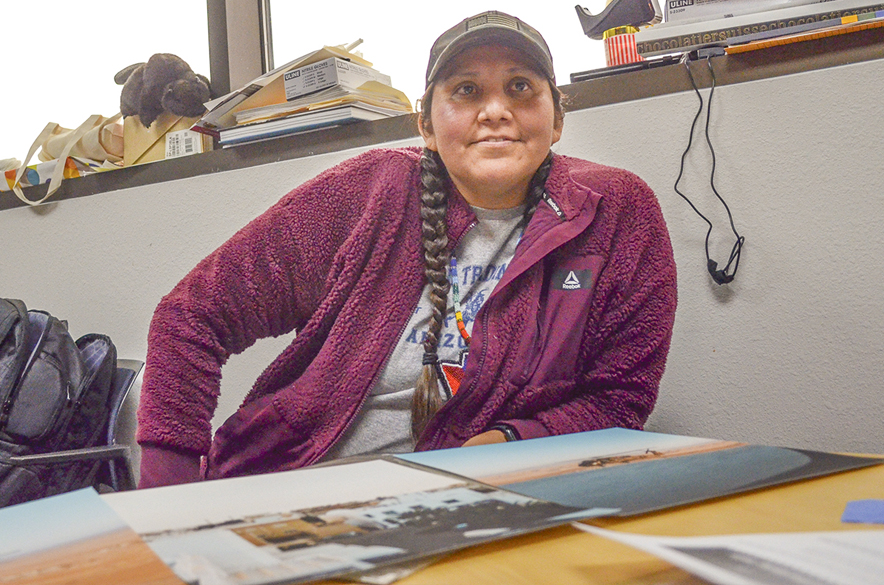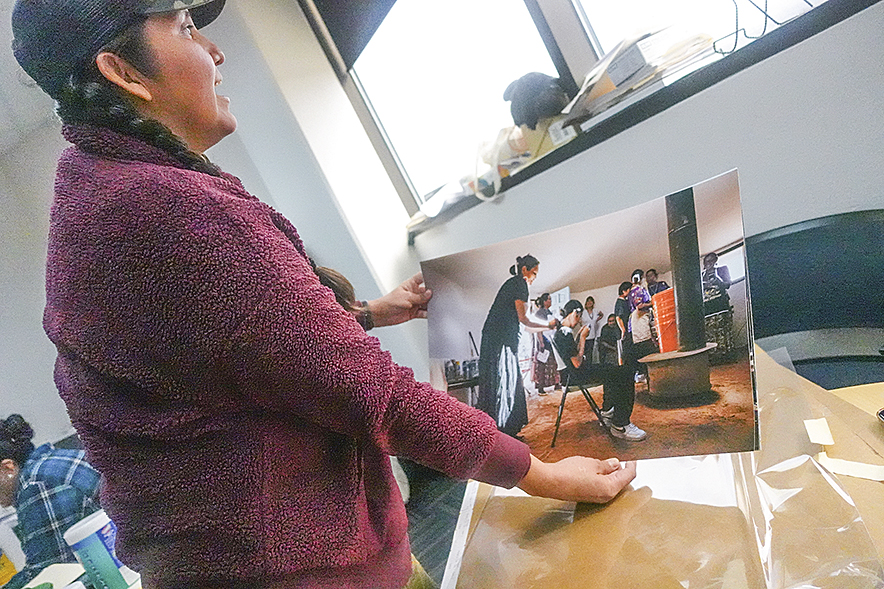
Samantha T. Begay, one of five DC student artists, to show work in ‘Between Worlds’

Navajo Times | Jan-Mikael Patterson
From disposable cameras to digital photography, Samantha T. Begay of Blue Gap, Ariz., is set to showcase her photography during the “Between Worlds” Student Exhibition on April 24 at 3:30 p.m. at Diné College in Tsaile, Ariz.
By Jan-Mikael Patterson
Navajo Times
TSAILE, Ariz. – The exciting part of looking through a photographer’s portfolio is learning how they view the world through their lens.
Samantha T. Begay has come a long way since her days as an amateur photographer. On April 24, at 3:30 p.m., she will be one of five artists to display their artistic expressions at the opening night of the “Between Worlds” Student Exhibit in the Ned A. Hatathli Museum at Diné College.
“Thinking about it now,” Begay said, “‘Wow, (my parents) really paid the money to get them printed and developed.
“And like, (the pictures) sucked,” she giggled, thinking back to the days before she had learned to use the medium as a form of expression.
“When I look back on them, I think, ‘Wow, they really had confidence in me.’”

Navajo Times | Jan-Mikael Patterson
On display is a photograph taken during some downtime during a kinaaldá for one of her nieces. Photographer Samantha T. Begay is shown tying her nephew’s hair into a tsiiyéél.
Begay, 34, is Tó’áhání born for Dził t’ahdi Kinyaa’áanii. Her cheii is Ta’neeszahnii and her nálí is Tsé Deeshgizhnii. She is from Blue Gap, Arizona, where she lives with her two daughters, Rogue, 5, and Nizhoni Nyugen, 8. Her husband, whom she met while serving in the Army, is Sgt. 1st Class Tuan Nyugen, 36. He is currently stationed in South Korea, in his 16th year serving in the Army.
Her parents are Phillip and Miranda Begay.
Begay is now a Diné College junior pursuing a bachelor’s in digital photography.
When asked how many photos she had taken since high school, Begay said, “Oh my gosh, I’d say thousands. But that’s how I got started.”
Her father, Phillip Begay, served 15 years in the Army and the Army National Guard, including tours in Iraq and Germany. Serving her country was an easy decision for Begay, as she enlisted after graduating high school.
After serving eight years, Samantha left the Army when she learned she was pregnant. It was a difficult decision because she wanted to continue serving. But she knew that not long after she delivered the baby, she would be given orders to deploy to Afghanistan.
It was the best decision Begay could have made because she now has two daughters to raise with the culture and traditions she is learning thanks to Dine College.
“I just always figured, I did my service, and now it’s time for me to do what I really enjoy and love,” she said.
And that’s photography.
“My (photography) journey takes me from being in high school where my father was really huge on photography,” Begay said. “Then I went into the (Army), and from there, I really got into photography, documenting my journey.”
Having photos she took from home with her while she was deployed to Kuwait, Iraq, and Germany helped with homesickness.
Begay’s father was supportive of buying her disposable film cameras. Her proudest moment was when she was gifted her father’s Nikon D80 DLSR camera, which he had taken with him when he was deployed to Iraq.
“That was when they were all new with the new specs and (technology),” Begay said. “It is the biggest sentimental item I have.”
The Nikon D80 has been discontinued. She currently uses the Fujifilm X-T30, Sony A6300, and Canon A1 film cameras.
After settling back into civilian life, Begay applied to Diné College’s main campus in Tsaile.
“I learned a lot of Navajo from the Navajo Language instructors,” she said. “I’ve gained so much here.”
Begay learned about the Navajo Creation stories and the different purposes of Navajo ceremonies that take place at various solstices, as well as the meaning of the stories and songs that accompany them.
“There is so much I gained,” she said.
As for digital photography, it wasn’t until she traveled with military friends, visiting historical sites and castles in Germany, that she noticed something changed in her camera use.
In the Army, she was a petroleum laboratory specialist, where she tested the fuel the Army used to ensure its acceptance.
“I actually did wedding photography (in Germany) for a little bit,” she said. “That’s where I started looking at the book the camera came with, the user’s manual, and other books. It was hard to find other books that were in English in Germany.
“It was all just to make my way because I was a private that was getting a private’s pay,” Begay said. “I didn’t have the funds at the time to make it back home. I was really homesick.”
Navajos are everywhere.
“I actually met a Navajo that lives out there who married a German,” she said. “I was like, ‘Wow, Navajos are everywhere.’ She was fluent in German too. I don’t remember her name. It was a one-day thing, a wedding. But she was there for 20 years, and she was fluent in German. I wish I remembered her name.”
Taking photography classes enhanced her perspective and allowed her to express herself through the viewfinder. Several of the photographs Begay had printed recently include images she captured of family during a kinaaldá.
“I got permission from the medicine (people) and family,” she said. “I had to because I didn’t want to disrespect the ceremony. I only used the camera when it was not during singing or prayer.”
One image she will display is the tying of the hair bun for her nephew during some downtime during the kinaaldá.
Families were in the hogan and hanging out before the ceremony continued. The image has natural lighting capturing everyone in the hogan while the hair-tying is taking place, and it is astonishingly detailed, thanks to the natural lighting sources from the window, the doorway, and the chimney opening.
“That same hogan is where I had my ceremony done,” she said.
Another image shows the family’s women removing the ‘alkąąd from the ground in the early morning.
The moment showed women in their traditional outfits removing pieces of the ‘alkąąd with smoke in the air. The women captured were captured in detail on a 24-by-36 full-colored print.
Another set of images she plans to showcase is fighter jets she captured while going to work on a helicopter on her way to work when she was stationed in Kuwait.
The jets are mid-air, and the photo captures the landscape below and behind them.
“The people and culture out there is much different from what you see on TV,” she said, noting that news media footage depict a war-torn city with conflict and explosions.
“There is a lot of culture and a lot of nice people,” Begay said.
She credits her instructors for looking beyond what she views through her camera to express what she is feeling. Some of the images she will exhibit will have her thoughts and expressions written on them,
For Samantha, it is about combining the evolving world with her traditions and culture as a Diné woman. She plans to continue with photography and use that to raise her daughters with Diné culture and tradition.
“Some of them will be priced to sell at the exhibit,” she said of the images that will be showcased. “Some of them are going to be given as gifts to the families that allowed me to take photos.”








 Highway 264,
Highway 264, I-40, WB @ Winslow
I-40, WB @ Winslow